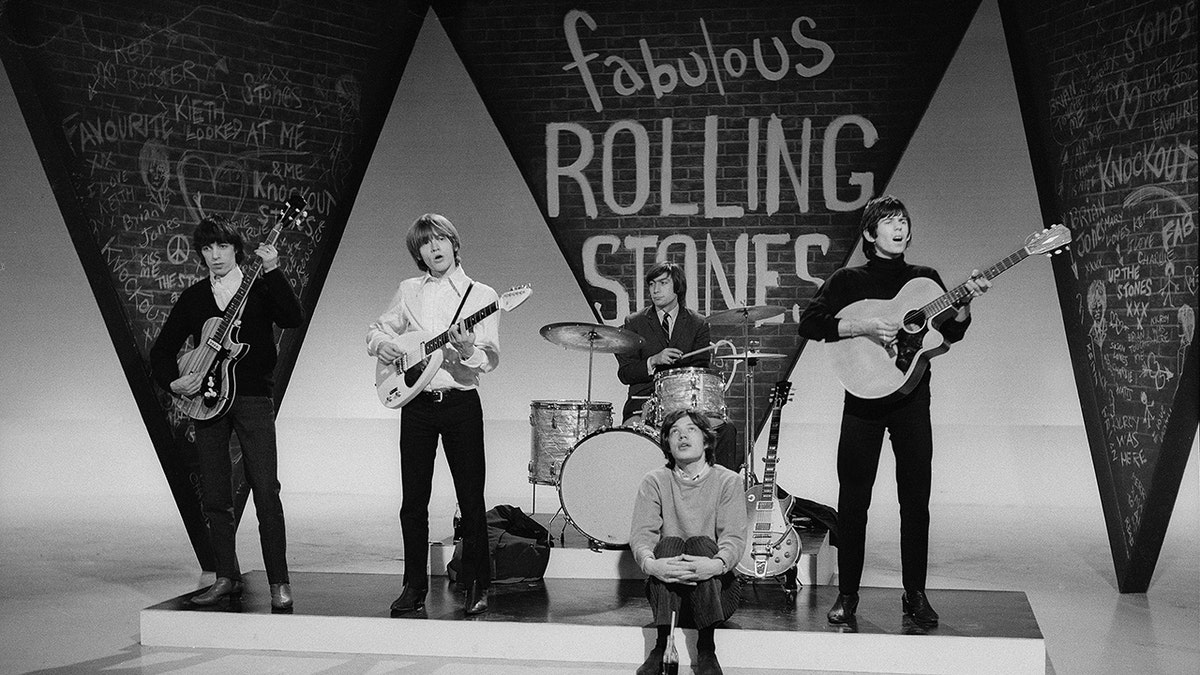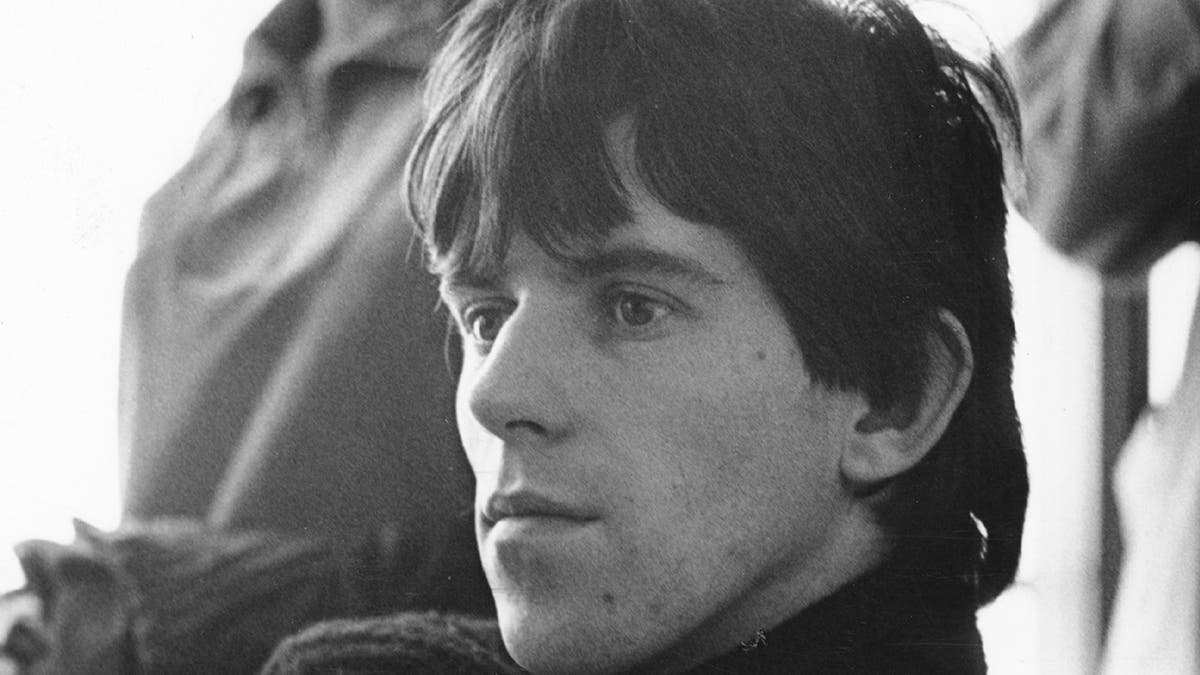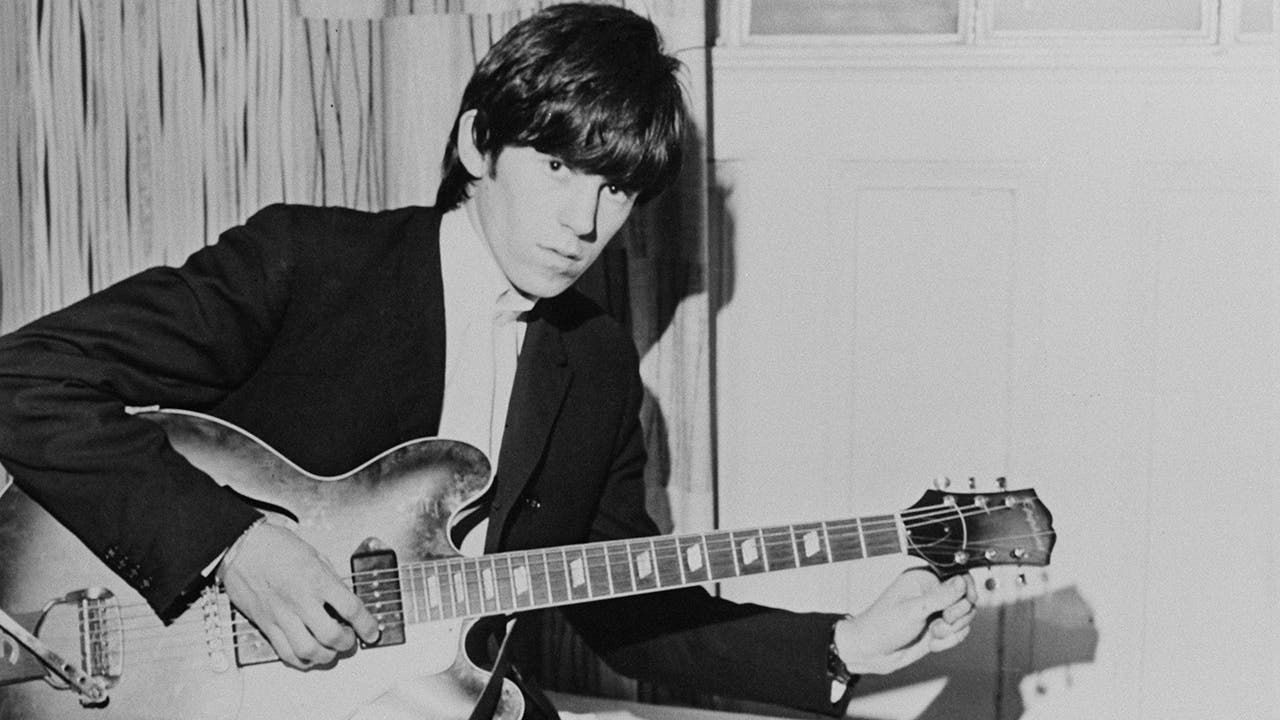The Rolling Stones, inspired by an incendiary riff that guitarist Keith Richards captured on tape while he was asleep, recorded their sensational rock anthem “(I Can't Get No) Satisfaction” on this day in history, May 12, 1965.
“The track is an electrified shot of rock and roll adrenaline,” enthuses British outlet Far Out Magazine.
“He doesn't stop to breathe and instead zooms through the air with a riff-powered jetpack,” adds that outlet.
ON THIS DAY IN HISTORY, MAY 11, 1888, IRVING BERLIN, COMPOSER OF 'GOD BLESS AMERICA', IS BORN
Released just four weeks later, “Satisfaction” became an international phenomenon.
It topped the US charts for four weeks in the summer of 1965. It also transformed Richards, his childhood friend Mick Jagger and the rest of the Rolling Stones from a newcomer British Invasion blues band to global rock stars.
The Rolling Stones in a television studio in 1965: Bill Wyman, Brian Jones, Mick Jagger, Keith Richards and Charlie Watts. (Michael Ward/Getty Images)
“For many, it is the quintessential rock song with its mix of fractured grammar ('can't get no'), its sense of rebellion and disillusionment, its anti-commercialist stance and, of course, its thumping guitar riff,” he said. . declared the Library of Congress when it added the hit to the US National Recording Registry in 2006.
It was the first of eight Billboard number one hits released by the Rolling Stones over the years, among dozens of other chart hits and rock classics on albums.
“The track is an electrified shot of rock and roll adrenaline.”
The riff on “Satisfaction” remains one of the most memorable in music history; However, the guitarist who dreamed it forgets its origins.
Keith Richards was a fresh-faced 21-year-old former art school student in the spring of 1965.

English guitarist Keith Richards of the Rolling Stones, circa 1965. (Keystone Features/Hulton Archive/Getty Images)
One morning he woke up to find the cassette tape he kept in a recorder next to his bed, rolled up to the end.
He rewound the tape and pressed play, and “a three-note guitar riff blasted out of the speakers, followed by some basic chords and a simple chorus,” the American Songwriter website reports.
THE HIDDEN HISTORY OF NEW YORK JIMI HENDRIX RECORDED HIS LAST TRACK IN THIS MANHATTAN RECORDING STUDIO HE BUILT HIMSELF
“'I can't get any satisfaction,' said the melody, sung by Richards in a sleepy, half-conscious voice. After several repetitions, the music faded away and gave way to 40 minutes of snoring,” the outlet adds.
Apparently, the guitarist had woken up in the middle of the night, unconsciously recorded one of the most famous licks in rock history on an acoustic guitar, and then gone back to sleep without remembering the incident.

The Rolling Stones, from left, Bill Wyman, Brian Jones, Charlie Watts, Mick Jagger (front) and Keith Richards, rehearse for an appearance on a British television show in 1965 in London, England. (Cyrus Andrews/Michael Ochs Archive/Getty Images)
The Rolling Stones recorded the song on May 12 at RCA Hollywood Studio, with Richards' opening chorus developed by Jagger's lyrics.
“I'm trying to get a girl to tell me/Baby better come back maybe next week,” he growls in a fit of youthful angst.
“After several repetitions, the music faded away and gave way to 40 minutes of snoring.”
The overt references to sexual frustration, scandalous at the time, only fueled the song's mythical reputation.
He also earned the scorn of television censors. The producers of “Shindig!” removed the obscene lyrics in the production.
MEET THE AMERICAN WHO INVENTED THE ELECTRIC GUITAR, INSPIRED BY ROCK 'N' ROLL
“It has a very catchy title. It has a very catchy guitar riff and a great guitar sound, which was original at the time,” Jagger said in a 1995 interview with Rolling Stone magazine.

A front-row ticket stub for the Rolling Stones' first American tour in 1965, beginning May 1, at the Philadelphia Convention Hall and Civic Center in Philadelphia, Pennsylvania. (Jeff Hochberg/Getty Images)
“And it encapsulated the feeling of the time, which was alienation. A kind of sexual alienation,” Jagger added.
Richards never intended for his riff to make the recording, much less rock history.
“Richards always assumed that a trumpet section would play the song's signature riff, going so far as to use a Gibson Fuzz Box at RCA Studios to imitate the sounds of a saxophone,” writes American Songwriter.
“It was supposed to be a provisional part, a scratch track, but Fuzz Box gave the song a frenetic, vibrant energy that everyone else seemed to prefer.”

Guitarist Keith Richards of the rock band The Rolling Stones in a candid portrait at the New York Hilton on October 28, 1965, in New York City. Richards wrote the band's big hit, “Satisfaction”, in the spring of 1966. (Michael Ochs Files/Getty Images)
The fuzz box effect not only remained, but created a new rock sound. Gibson sold out the team before the year was out.
Otis Redding, meanwhile, recorded a trumpet-driven version of “Satisfaction” later in 1965.
Devo recorded a new-wave version in 1977.
The song made the Rolling Stones global superstars, a status they still enjoy today.
CLICK HERE TO GET THE FOX NEWS APP
The band celebrated 60 years of satisfying global audiences with a European tour in 2022.
“His playing is idiosyncratic, loose, difficult to copy… and the stuff of legend,” Guitar.com writes of rock god Richards, who is 80 years old.
“Among all the colorful myths and legends of Keith Richards' life, it is sometimes easy to forget that he is actually a very “Good guitarist… and somewhat innovative,” the outlet also said.

Keith Richards of the Rolling Stones performs live on stage during a Rolling Stones concert at the Johan Cruijff Arena on July 7, 2022, in Amsterdam, Netherlands. (Sven Hoogerhuis/BSR Agency/Getty Images)
“The fuzz tone had never been heard anywhere before, and that's the sound that captured everyone's imagination,” Richards wrote in “Life,” his 2010 autobiography.
The song's success as the defining hit of the summer of 1965 taught the guitarist the value of teamwork in the creative process.
CLICK HERE TO SUBSCRIBE TO OUR LIFESTYLE NEWSLETTER
“I learned that lesson: sometimes you can work too hard,” Richards wrote.
“Not everything is designed for your taste and your taste only.”
For more lifestyle articles, visit www.foxnews.com/lifestyle.












